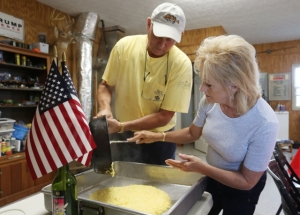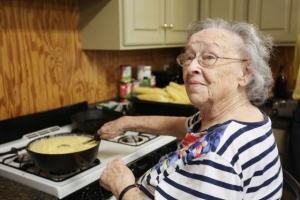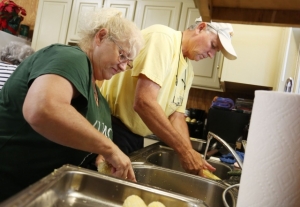Carrying on a family tradition
By Steve Herring
Published in News on July 11, 2018 5:50 AM

News-Argus/CASEY MOZINGO
Grey Morgan pours blanched corn into a pan as his wife, Gloria, stirs to aid with the cooling process.

News-Argus/CASEY MOZINGO
Gaynell Brock blanches a skillet of corn to prepare it for freezing.

News-Argus/CASEY MOZINGO
Debbie Grady and her brother-in-law Grey Morgan cut corn off the cob.
MOUNT OLIVE -- Perched on a stool in front of the oven, Gaynell Brock stirs an ancient cast iron skillet of bubbling corn.
She watches for the tell-tale signs that the corn is properly blanched.
At the sink, her daughter, Debbie Grady, and her son-in-law, Grey Morgan, cut the corn off the cob.
Morgan pours the corn into the skillet, and once it is blanched, he pours it into a large pan where his wife and Brock's daughter, Gloria, stirs the corn to help with the cooling process.
The cooled corn is then poured into quart freezer bags.
It is a fading practice that traces its heritage back to a time when people shucked corn as they sat under the shade of a large tree -- to a time when they canned vegetables for the winter.
But this year, the family didn't have to shuck the 720 ears of corn. It was ready when it arrived from the farm of Michael and Tracy Price of Seven Springs -- Gaynell Brock's nephews.
"If it hadn't been shucked, it would have taken us two days," Brock said.
And instead of working outside, they were in an air-conditioned building at the Morgans' home just east of Mount Olive in Duplin County.
But they all agree that even then it is still a lot of work.
"Every year we say we don't know if we are going to do it or not," Grey Morgan said.
But of course they still do it, he said.
It is a dying art because it is a lot of work and people don't want to do it, especially if someone is doing it my themselves, Brock said.
"But this winter it is worth it," Grady said.
"You can't buy anything in the grocery store like this," Gloria Brock said.
They were expecting to get between 55 and 60 bags from the 720 ears.
Gaynell Brock, whose family operated the Southern Belle restaurant for nearly 50 years until it closed in 2013, jokes that she has done it a "few times," but does not recall the first time.
"I used to watch mama and grandmama do it," Brock said. "That is the way we do it. We do it like my mama did it."
"A lot of people now blanch it on the cob and cool it and then cut it off that way, and put it in the bags," Grady said.
They say it is easier that way, Brock said.
"But we still do it raw off the cob, blanch it, cool it, put it in bags," Grady said.
Grey Morgan said that Brock always starts off with just a little bit of boiling water in her heavy old-fashioned cast iron pans.
The pans are the same ones she used at the Southern Belle.
That is the way she learned from her mother, Brock said.
"They said it keeps it from sticking," she said. "I don't know if it does or not, but that is what I have always done. So far I haven't had any to stick."
She doesn't worry about the temperature, she just cooks the corn until it bubbles up "real good" and turns just a little lighter color.
Blanched corn will keep in the freezer for several years, but only for about six or eight months if it isn't blanched, Brock said.
"It was the good old days, but it was the work days," Brock said. "They would let us shuck, but we didn't get to cut any off the cob until we got grown. You grew everything you ate back then. She had hogs. We had our cows.
"When we were growing up, we would sit outside because you didn't have much air conditioners. If you were lucky, you might have a window unit."
She said her aunts would all get together, and they would go outside and shuck corn. One would cut it off the cob with a knife, and another one would be in the kitchen blanching it, she said.
Grady said that her grandmother also would freeze water in old milk cartons.
She would place the plans of still hot corn inside water with the blocks of ice to help cool the corn quicker, Grady said.
"Everybody had their own way," she said. "But we have never done the freezing blocks of ice."
It is a lot of work, but it pays off later on when the bags are opened and the corn served, they said.
Within the next few weeks, they will switch from corn to canning tomatoes, Brock said.
"Used to, you sat under the tree, and you just peeled them," she said. "You washed them. You peeled them and quartered them and put them in the pot."
And like blanching corn, the family has learned a few shortcuts, Grady said.
"But we found out if you 'x' the bottom, drop them into boiling water for about a minute and then take them out and drop them into cool water, the peels just fall off of them."
